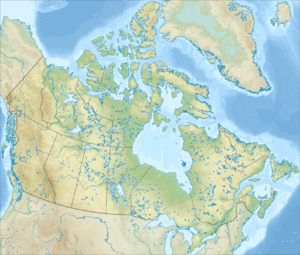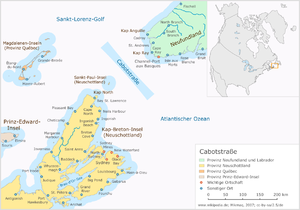Cabot Street
| Cabot Street | ||
|---|---|---|
| Connects waters | Gulf of Saint Lawrence | |
| with water | Atlantic Ocean | |
| Separates land mass | Newfoundland | |
| of land mass | Cape Breton Island | |
| Data | ||
| Geographical location | 47 ° 14 ′ N , 59 ° 43 ′ W | |
|
|
||
| Smallest width | 110 km | |
| Coastal towns | Port aux Basques | |
| Islands | Saint Paul Island | |
| Cabot Street | ||
The Cabot Strait ( English Cabot Strait , French Détroit de Cabot ) is a strait of the sea in Atlantic Canada .
It lies between Newfoundland and Cape Breton Island and is by far the widest of the three exits that connect the Gulf of Saint Lawrence to the Atlantic Ocean . The other two exits are Canso Street and Belle Isle Street .
The narrowest point of the Cabot Strait is between Cape North on Cape Breton Island and Cape Ray on Newfoundland, in this section the Cabot Strait measures about 110 kilometers.
history
The strait was named after the Italian navigator Giovanni Caboto , who explored the area around Cabotstrasse in 1497 on an expedition on behalf of the English.
It has been a strategically important sea route throughout Canadian history. It is still one of the most important international shipping routes today. It is the most important shipping route that connects the Atlantic Ocean with the inland ports of the Great Lakes via the St. Lawrence Seaway . The Cabot Strait is also crossed by a daily ferry line which, as a maritime section of the Trans-Canada Highway, connects the two cities of Port aux Basques on Newfoundland and North Sydney on Cape Breton Island . The first ferry service across the strait had been established in 1898, and by 1856 a submarine telegraph cable had been installed as part of a transatlantic telegraph cable project by the New York, Newfoundland and London Telegraph Company under the direction of Frederick Newton Gisborne .
St. Paul Island , located in the southeastern area of Cabotstrasse, was a dreaded danger point for shipping during the sailing age. The often mist-shrouded island was the undoing of numerous ships during this era, which earned it the nickname “ Graveyard of the Gulf” (meaning the Gulf of St. Lawrence).
The worst shipping disaster to date in Cabotstrasse occurred on October 14, 1942, when the passenger ferry Caribou was torpedoed by the German submarine U 69 in front of Channel Head without warning and sank within five minutes. 136 passengers and crew members were killed.

